An Empirical Analysis of Sediment Export Dynamics from a Constructed Landform in the Wet Tropics
Abstract
1. Introduction
2. Study Area
3. Methods of Data Analysis
4. Results
4.1. Rainfall and Runoff Summary
4.2. Annual and Seasonal Variability
4.3. Bedload Controls
4.4. Turbidity Controls at the Event Scale
4.5. Turbidity Controls at the Intra-Event Scale
5. Discussion
5.1. Sediment Loads
5.2. Relationship between the Rainfall–Runoff and Sediment Load
5.3. Event Dynamics
5.4. Limitations of the Analysis
5.5. Significance for Predictive Modelling
6. Conclusions
- The bedload exported from the plot was strongly and nonlinearly related to the runoff (and rainfall) volume, and the bedload per unit volume of runoff continually reduced over the five years.
- The nonlinear relationship between the suspended sediment concentration (as indicated by turbidity data) and runoff also changed over the years, with similar rainfall–runoff events in later years producing considerably lower turbidity.
Author Contributions
Funding
Institutional Review Board Statement
Informed Consent Statement
Data Availability Statement
Acknowledgments
Conflicts of Interest
Appendix A. Infilling the Missing SSC Data
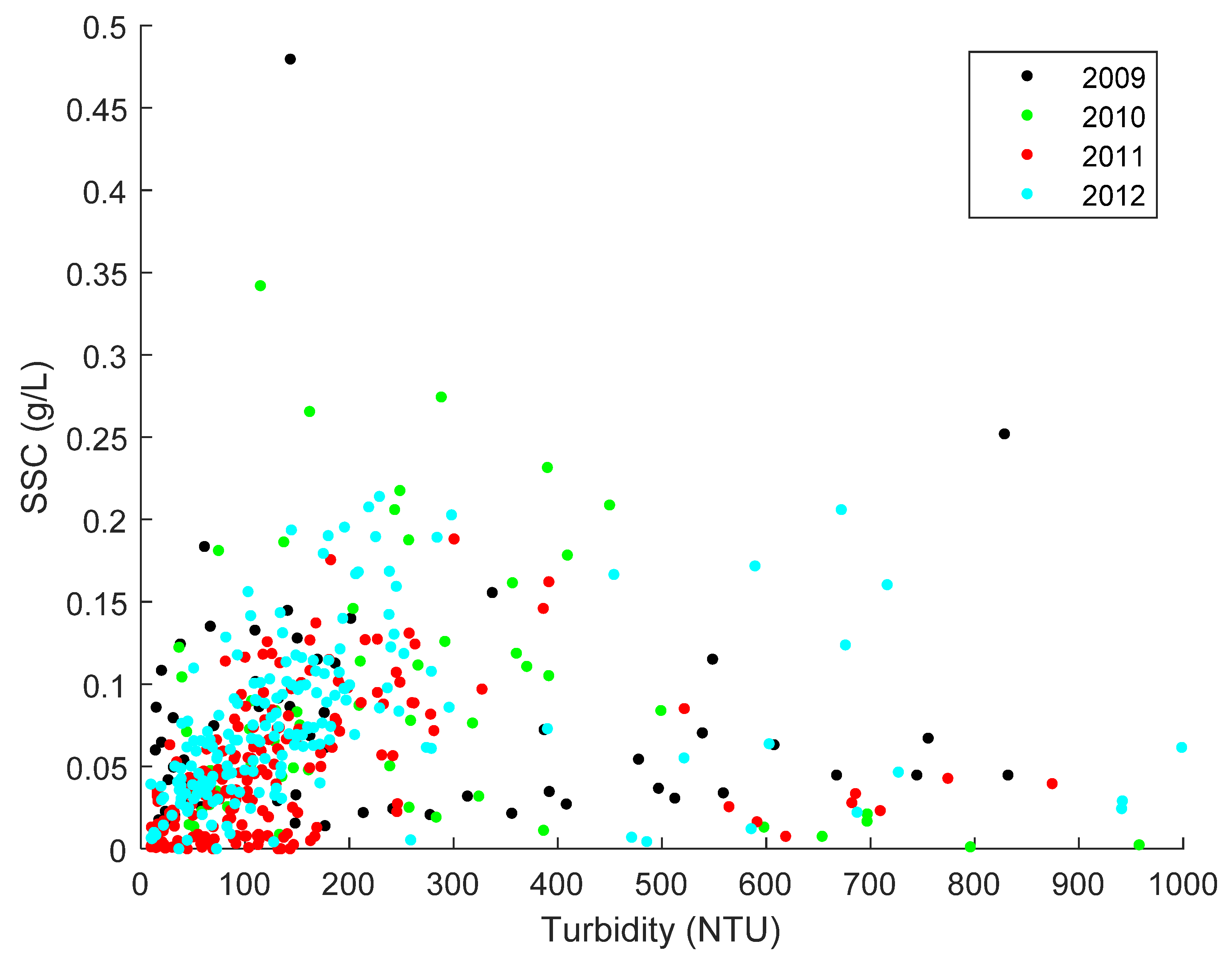
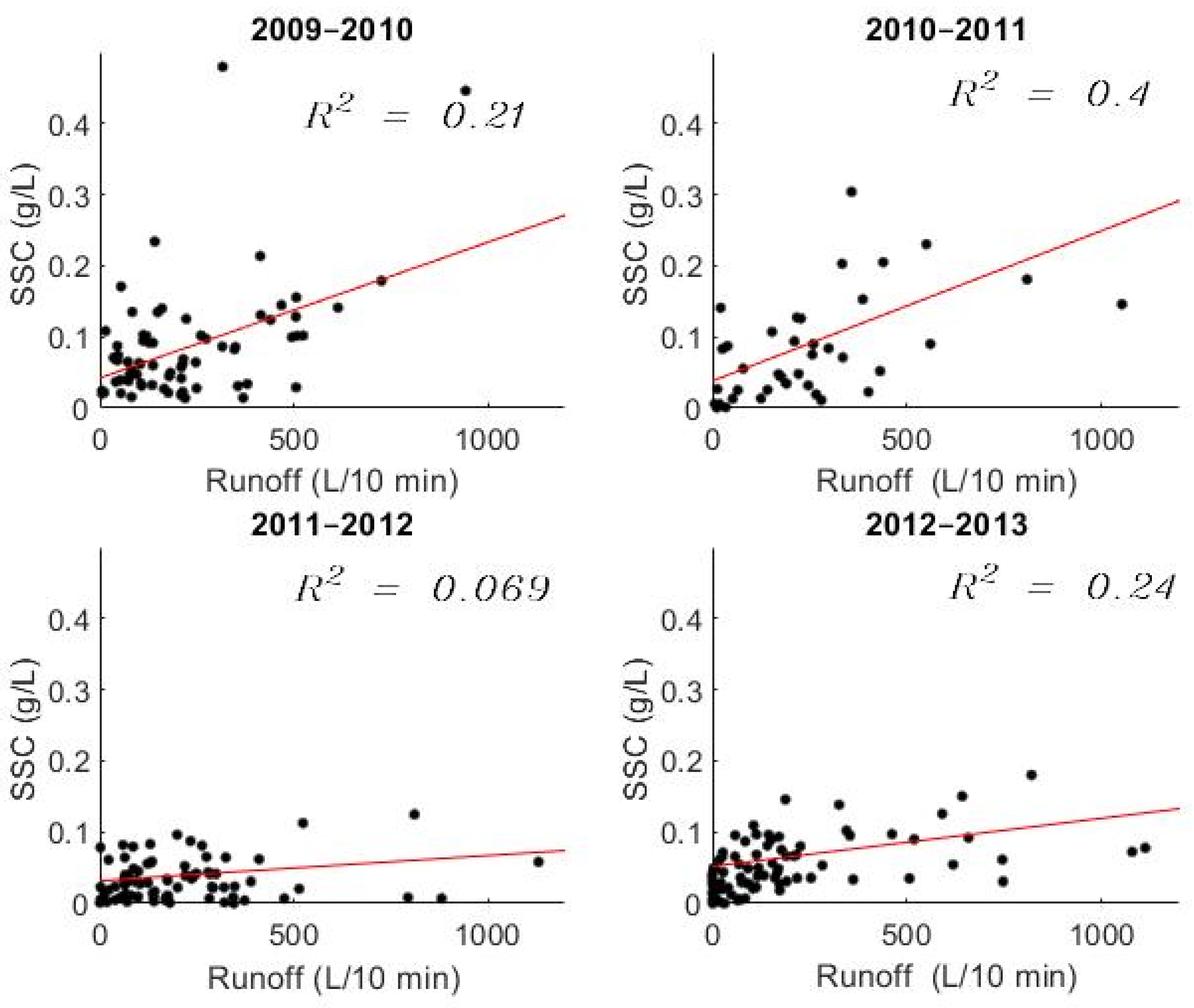
Appendix B. Illustrating the Seasonal Variability of Climate, Runoff and Suspended Sediments
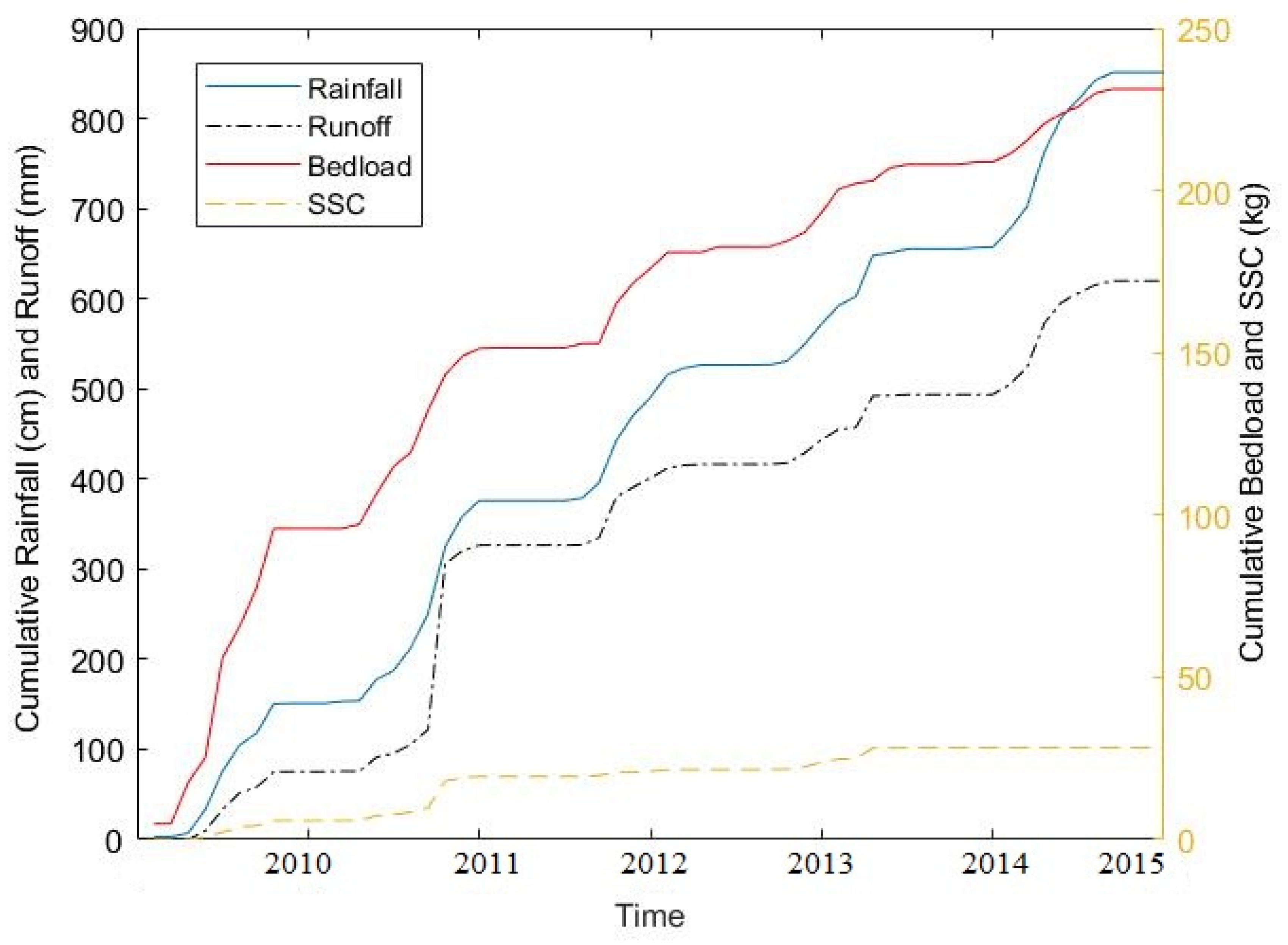
Appendix C. Characterising the Runoff–NTU Hysteresis

References
- Riley, S.J. Aspects of the differences in the erodibility of the waste rock dump and natural surfaces, Ranger Uranium Mine, Northern Territory, Australia. Appl. Geogr. 1995, 15, 309–323. [Google Scholar] [CrossRef]
- Martín-Duque, J.F.; Zapico, I.; Oyarzun, R.; López García, J.A.; Cubas, P. A descriptive and quantitative approach regarding erosion and development of landforms on abandoned mine tailings: New insights and environmental implications from SE Spain. Geomorphology 2015, 239, 1–16. [Google Scholar] [CrossRef]
- Nyssen, J.; Vermeersch, D. Slope aspect affects geomorphic dynamics of coal mining spoil heaps in Belgium. Geomorphology 2010, 123, 109–121. [Google Scholar] [CrossRef]
- Martín-Moreno, C.; Martín-Duque, J.F.; Nicolau-Ibarra, J.M.; Hernando-Rodríguez, N.; Sanz-Santos, M.Á.; Sánchez-Castillo, L. Effects of topography and surface soil cover on erosion for mining reclamation: The experimental spoil heap at El Machorro Mine (Central Spain). Land Degrad. Dev. 2016, 27, 145–159. [Google Scholar] [CrossRef]
- Panagos, P.; Borrelli, P.; Meusburger, K.; Yu, B.; Klik, A.; Jae Lim, K.; Yang, J.; Ni, J.; Miao, C.; Chattopadhyay, N.; et al. Global rainfall erosivity assessment based on high-temporal resolution rainfall records. Sci. Rep. 2017, 7, 4175. [Google Scholar] [CrossRef]
- Guzman, C.D.; Tilahun, S.A.; Zegeye, A.D.; Steenhuis, T.S. Suspended sediment concentration-discharge relationships in the (sub-) humid Ethiopian highlands. Hydrol. Earth Syst. Sci. 2013, 17, 1067. [Google Scholar] [CrossRef]
- Thomas, S.; Ridd, P.V.; Day, G. Turbidity regimes over fringing coral reefs near a mining site at Lihir Island, Papua New Guinea. Mar. Pollut. Bull. 2003, 46, 1006–1014. [Google Scholar] [CrossRef]
- Alavinia, M.; Saleh, F.N.; Asadi, H. Effects of rainfall patterns on runoff and rainfall-induced erosion. Int. J. Sediment. Res. 2018, 34, 270–278. [Google Scholar] [CrossRef]
- Arjmand Sajjadi, S.; Mahmoodabadi, M. Sediment concentration and hydraulic characteristics of rain-induced overland flows in arid land soils. J. Soils Sediments 2015, 15, 710–721. [Google Scholar] [CrossRef]
- Walker, P.H.; Kinnell, P.I.A.; Green, P. Transport of a noncohesive sandy mixture in rainfall and runoff experiments. Soil Sci. Soc. Am. J. 1978, 42, 793–801. [Google Scholar] [CrossRef]
- Balacco, G. The interrill erosion for a sandy loam soil. Int. J. Sediment. Res. 2013, 28, 329–337. [Google Scholar] [CrossRef]
- Wang, Y.; You, W.; Fan, J.; Jin, M.; Wei, X.; Wang, Q. Effects of subsequent rainfall events with different intensities on runoff and erosion in coarse soil. Catena 2018, 170, 100–107. [Google Scholar] [CrossRef]
- Shen, H.; Zheng, F.; Wen, L.; Han, Y.; Hu, W. Impacts of rainfall intensity and slope gradient on rill erosion processes at loessial hillslope. Soil Till. Res. 2016, 155, 429–436. [Google Scholar] [CrossRef]
- Fang, N.-F.; Shi, Z.-H.; Li, L.; Guo, Z.-L.; Liu, Q.-J.; Ai, L. The effects of rainfall regimes and land use changes on runoff and soil loss in a small mountainous watershed. Catena 2012, 99, 1–8. [Google Scholar] [CrossRef]
- Peng, T.; Wang, S.-J. Effects of land use, land cover and rainfall regimes on the surface runoff and soil loss on karst slopes in southwest China. Catena 2012, 90, 53–62. [Google Scholar] [CrossRef]
- van Dijk, A.; Bruijnzeel, L.A.; Rosewell, C.J. Rainfall intensity-kinetic energy relationships: A critical literature appraisal. J. Hydrol. 2002, 261, 1–23. [Google Scholar] [CrossRef]
- Parsons, A.J.; Stone, P.M. Effects of intra-storm variations in rainfall intensity on interrill runoff and erosion. Catena 2006, 67, 68–78. [Google Scholar] [CrossRef]
- Flanagan, D.; Foster, G.; Moldenhauer, W. Storm pattern effect on infiltration, runoff, and erosion. Am. Soc. Agric. Biol. Eng. 1988, 31, 414–420. [Google Scholar] [CrossRef]
- Tao, W.; Wu, J.; Wang, Q. Mathematical model of sediment and solute transport along slope land in different rainfall pattern conditions. Sci. Rep. 2017, 7, 44082. [Google Scholar] [CrossRef]
- Zabaleta, A.; Martínez, M.; Uriarte, J.A.; Antigüedad, I. Factors controlling suspended sediment yield during runoff events in small headwater catchments of the Basque Country. Catena 2007, 71, 179–190. [Google Scholar] [CrossRef]
- Walker, P.; Hutka, J.; Moss, A.; Kinnell, P.I.A. Use of a versatile experimental system for soil erosion studies 1. Soil Sci. Soc. Am. J. 1977, 41, 610–612. [Google Scholar] [CrossRef]
- Saynor, M.J.; Lowry, J.B.C.; Boyden, J.M. Assessment of rip lines using CAESAR-Lisflood on a trial landform at the Ranger Uranium Mine. Land Degrad. Dev. 2019, 30, 504–514. [Google Scholar] [CrossRef]
- Gao, G.; Ma, Y.; Fu, B. Temporal Variations of flow–sediment relationships in a highly erodible catchment of the loess plateau, China. Land Degrad. Dev. 2016, 27, 758–772. [Google Scholar] [CrossRef]
- Zheng, M.; Yang, J.; Qi, D.; Sun, L.; Cai, Q. Flow–sediment relationship as functions of spatial and temporal scales in hilly areas of the Chinese Loess Plateau. Catena 2012, 98, 29–40. [Google Scholar] [CrossRef]
- Kiani-Harchegani, M.; Sadeghi, S.; Ghahramani, A. Intra-storm Variability of Coefficient of Variation of Runoff and Soil Loss in Consecutive Storms at Experimental Plot Scale. In Climate Change Impacts on Hydrological Processes and Sediment Dynamics: Measurement, Modelling and Management; Springer: Berlin, Germany, 2019; pp. 98–103. [Google Scholar]
- Anache, J.A.A.; Wendland, E.C.; Oliveira, P.T.S.; Flanagan, D.C.; Nearing, M.A. Runoff and soil erosion plot-scale studies under natural rainfall: A meta-analysis of the Brazilian experience. Catena 2017, 152, 29–39. [Google Scholar] [CrossRef]
- Sadeghi, S.H.R.; Seghaleh, M.B.; Rangavar, A.S. Plot sizes dependency of runoff and sediment yield estimates from a small watershed. Catena 2013, 102, 55–61. [Google Scholar] [CrossRef]
- Liu, Y.; Fu, B.; Lü, Y.; Wang, Z.; Gao, G. Hydrological responses and soil erosion potential of abandoned cropland in the Loess Plateau, China. Geomorphology 2012, 138, 404–414. [Google Scholar] [CrossRef]
- Cerdan, O.; Govers, G.; Le Bissonnais, Y.; Van Oost, K.; Poesen, J.; Saby, N.; Gobin, A.; Vacca, A.; Quinton, J.; Auerswald, K.; et al. Rates and spatial variations of soil erosion in Europe: A study based on erosion plot data. Geomorphology 2010, 122, 167–177. [Google Scholar] [CrossRef]
- Fu, B.; Zhao, W.; Chen, L.; Zhang, Q.; Lü, Y.; Gulinck, H. Assessment of soil erosion at large watershed scale using RUSLE and GIS: A case study in the Loess Plateau of China. Land Degrad. Dev. 2005, 16, 73–85. [Google Scholar] [CrossRef]
- Jetten, V.; De Roo, A.; Favis-Mortlock, D.J.C. Evaluation of field-scale and catchment-scale soil erosion models. Catena 1999, 37, 521–541. [Google Scholar] [CrossRef]
- Bagarello, V.; Ferro, V. Plot-scale measurement of soil erosion at the experimental area of Sparacia (southern Italy). Hydrol. Process. 2004, 18, 141–157. [Google Scholar] [CrossRef]
- Shit, P.K.; Bhunia, G.S.; Maiti, R. Science, E. Effect of vegetation cover on sediment yield: An empirical study through plots experiment. Environ. Earth Sci. 2012, 2, 32–40. [Google Scholar]
- Moreno-de las Heras, M.; Nicolau, J.M.; Merino-Martín, L.; Wilcox, B.P. Plot-scale effects on runoff and erosion along a slope degradation gradient. Water Resour. Res. 2010, 46, 12. [Google Scholar] [CrossRef]
- Boix-Fayos, C.; Martínez-Mena, M.; Arnau-Rosalén, E.; Calvo-Cases, A.; Castillo, V.; Albaladejo, J. Measuring soil erosion by field plots: Understanding the sources of variation. Earth Sci. Rev. 2006, 78, 267–285. [Google Scholar] [CrossRef]
- Godone, D.; Stanchi, S. Research on Soil Erosion; InTech Open: London, UK, 2012. [Google Scholar] [CrossRef]
- Chaplot, V.; Le Bissonnais, Y. Field measurements of interrill erosion under different slopes and plot sizes. Earth Surf. Process. Landf. 2000, 25, 145–153. [Google Scholar] [CrossRef]
- Hu, J.; Zhao, G.; Mu, X.; Hörmann, G.; Tian, P.; Gao, P.; Sun, W. Effect of soil and water conservation measures on regime-based suspended sediment load during floods. Sustain. Cities Soc. 2020, 55, 102044. [Google Scholar] [CrossRef]
- Sadeghi, S.H.; Moosavi, V.; Karami, A.; Behnia, N. Soil erosion assessment and prioritization of affecting factors at plot scale using the Taguchi method. J. Hydrol. 2012, 448-449, 174–180. [Google Scholar] [CrossRef]
- Temple, P.H. Measurements of runoff and soil erosion at an erosion plot scale with particular reference to Tanzania. Geogr. Ann. Ser. A Phys. Geogr. 1972, 54, 203–220. [Google Scholar] [CrossRef]
- Lowry, J.B.C.; Narayan, M.; Hancock, G.R.; Evans, K.G. Understanding post-mining landforms: Utilising pre-mine geomorphology to improve rehabilitation outcomes. Geomorphology 2019, 328, 93–107. [Google Scholar] [CrossRef]
- Festin, E.S.; Tigabu, M.; Chileshe, M.N.; Syampungani, S.; Odén, P.C. Progresses in restoration of post-mining landscape in Africa. J. For. Res. 2019, 30, 381–396. [Google Scholar] [CrossRef]
- Saynor, M.J.; Lowry, J.; Erskine, W.D.; Coulthard, T.; Hancock, G.; Jones, D.; Lu, P. Assessing erosion and run-off performance of a trial rehabilitated mining landform. In Proceedings of the Life of Mine Conference, Brisbane, QLD, Australia, 10–12 July 2012; pp. 10–12. [Google Scholar]
- Saynor, M.J.; Erskine, W.D. Bed load losses from experimental plots on a rehabilitated uranium mine in northern Australia. In Proceedings of the Life of Mine Conference, Brisbane, QLD, Australia, 28–30 September 2016. [Google Scholar]
- Zhang, L.-T.; Gao, Z.-L.; Yang, S.-W.; Li, Y.-H.; Tian, H.-W. Dynamic processes of soil erosion by runoff on engineered landforms derived from expressway construction: A case study of typical steep spoil heap. Catena 2015, 128, 108–121. [Google Scholar] [CrossRef]
- Verbist, B.; Poesen, J.; van Noordwijk, M.; Widianto; Suprayogo, D.; Agus, F.; Deckers, J. Factors affecting soil loss at plot scale and sediment yield at catchment scale in a tropical volcanic agroforestry landscape. Catena 2010, 80, 34–46. [Google Scholar] [CrossRef]
- Hancock, G.R.; Evans, K.G.; Willgoose, G.R.; Moliere, D.R.; Saynor, M.J.; Loch, R.J. Medium-term erosion simulation of an abandoned mine site using the SIBERIA landscape evolution model. Soil Res. 2000, 38, 249–264. [Google Scholar] [CrossRef]
- Lacy, H. Mine landforms in Western Australia from dump to landform design: Review, reflect and a future direction. In Proceedings of the 13th International Conference on Mine Closure, Perth, Australia, 3–5 September 2019; pp. 371–384. [Google Scholar]
- Hancock, G.R.; Grabham, M.K.; Martin, P.; Evans, K.G.; Bollhöfer, A. A methodology for the assessment of rehabilitation success of post mining landscapes—sediment and radionuclide transport at the former Nabarlek uranium mine, Northern Territory, Australia. Sci. Total. Environ. 2006, 354, 103–119. [Google Scholar] [CrossRef]
- Australian Government. Environmental Requirements of the Commonwealth of Australia for the Operation of Ranger Uranium Mine. 1999; p. 1e11. Available online: https://www.environment.gov.au/science/supervising-scientist/publications/environmentalrequirements-ranger-uranium-mine (accessed on 22 June 2020).
- Hancock, G.; Saynor, M.; Lowry, J.; Erskine, W. How to account for particle size effects in a landscape evolution model when there is a wide range of particle sizes. Environ. Model. Softw. 2020, 124, 104582. [Google Scholar] [CrossRef]
- ERA. Unique Reference: 1400 Ranger Mine Closure Plan; Australian Government, Department of the Environment and Energy: Darwin, Australia, 2018. [Google Scholar]
- Li, G.-L.; Zheng, T.H.; Fu, Y.; Li, B.Q.; Zhang, T. Soil detachment and transport under the combined action of rainfall and runoff energy on shallow overland flow. J. Mt. Sci. 2017, 14, 1373–1383. [Google Scholar] [CrossRef]
- Chen, J.; Chang, H. Dynamics of wet-season turbidity in relation to precipitation, discharge, and land cover in three urbanizing watersheds, Oregon. River Res. Appl. 2019, 35, 892–904. [Google Scholar] [CrossRef]
- Schneider, J.M.; Turowski, J.M.; Rickenmann, D.; Hegglin, R.; Arrigo, S.; Mao, L.; Kirchner, J.W. Scaling relationships between bed load volumes, transport distances, and stream power in steep mountain channels. Geophys. Res. Earth Surf. 2014, 119, 533–549. [Google Scholar] [CrossRef]
- Saynor, M.; Lowry, J.; Boyden, J. The impact of rip lines on erosion at the Ranger mine site. In Proceedings of the Life of Mine Conference 2018, Brisbane, QLD, Australia, 25–27 July 2018; pp. 150–154. [Google Scholar]
- Duggan, K. Erosion and sediment yields in the Kakadu region of northern Australia. Stream Eros. Sediment. Transp. 1994, 224, 373384. [Google Scholar]
- Wei, W.; Chen, L.; Fu, B.; Huang, Z.; Wu, D.; Gui, L. The effect of land uses and rainfall regimes on runoff and soil erosion in the semi-arid loess hilly area, China. J. Hydrol. 2007, 335, 247–258. [Google Scholar] [CrossRef]
- So, H. Sealing, crusting and hardsetting soils: Productivity and conservation. In Proceedings of the second International Symosium on Sealing, Crusting and Hardsetting Soils: Productivity and Conservation held at the University of Queensland, Brisbane, QLD, Australia, 7–11 February 1994. [Google Scholar]
- Blackwell, P.S. Slaking and hard setting soils: Some research and management aspects. Soil Till. Res. 1992, 25, 111–261. [Google Scholar] [CrossRef]
- Mohamadi, M.A.; Kavian, A. Effects of rainfall patterns on runoff and soil erosion in field plots. Int. Soil Water Conserv. Res. 2015, 3, 273–281. [Google Scholar] [CrossRef]
- Kidron, G.J.; Xiao, B.; Benenson, I. Data variability or paradigm shift. Slow versus fast recovery of biological soil crusts-a review. Sci. Total Environ. 2020, 721, 137683. [Google Scholar] [CrossRef]
- Gonzalez-Hidalgo, J.C.; Batalla, R.J.; Cerda, A.; de Luis, M. A regional analysis of the effects of largest events on soil erosion. Catena 2012, 95, 8–590. [Google Scholar] [CrossRef]
- Wei, W.; Chen, L.; Fu, B.; Lü, Y.; Gong, J.J.H.P.A.I.J. Responses of water erosion to rainfall extremes and vegetation types in a loess semiarid hilly area, NW China. Hydrol. Process. 2009, 23, 1780–1791. [Google Scholar] [CrossRef]
- Miura, S.; Hirai, K.; Yamada, T. Transport rates of surface materials on steep forested slopes induced by raindrop splash erosion. J. For. Res. 2002, 7, 201–211. [Google Scholar] [CrossRef]
- Oeurng, C.; Sauvage, S.; Sánchez-Pérez, J.-M. Dynamics of suspended sediment transport and yield in a large agricultural catchment, southwest France. Earth Surf. Process. Landf. 2010, 35, 1289–1301. [Google Scholar] [CrossRef]
- Shen, C.; Liao, Q.; Titi, H.H.; Li, J. Turbidity of stormwater runoff from highway construction sites. Environ. Eng. 2018, 144, 04018061. [Google Scholar] [CrossRef]
- Moliere, D.R.; Evans, K.G.; Saynor, M.J.; Erskine, W.D. Estimation of suspended sediment loads in a seasonal stream in the wet-dry tropics, Northern Territory, Australia. Hydrol. Process. 2004, 18, 531–544. [Google Scholar] [CrossRef]
- Solano-Rivera, V.; Geris, J.; Granados-Bolaños, S.; Brenes-Cambronero, L.; Artavia-Rodríguez, G.; Sánchez-Murillo, R.; Birkel, C. Exploring extreme rainfall impacts on flow and turbidity dynamics in a steep, pristine and tropical volcanic catchment. Catena 2019, 182, 104118. [Google Scholar] [CrossRef]
- Kheirfam, H.; Sadeghi, S.H. Variability of bed load components in different hydrological conditions. J. Hydrol. Reg. Stud. 2017, 10, 145–156. [Google Scholar] [CrossRef]
- Lewis, J. Turbidity-controlled sampling for suspended sediment load estimation. Technological and Methodological Advances. In Proceedings of the Oslo Workshop; Bogen, J., Fergus, T., Walling, D.E., Eds.; IAHS Press: Wallingford, CT, USA, 2003; pp. 13–20. [Google Scholar]
- Riley, S.J. The sediment concentration–turbidity relation: Its value in monitoring at Ranger Uranium Mine, Northern Territory, Australia. Catena 1998, 32, 1–14. [Google Scholar] [CrossRef]
- Moliere, D.; Saynor, M.; Evans, K. Suspended sediment concentration-turbidity relationships for Ngarradj–a seasonal stream in the wet-dry tropics. Australas. J. Water Resour. 2005, 9, 37–48. [Google Scholar] [CrossRef]
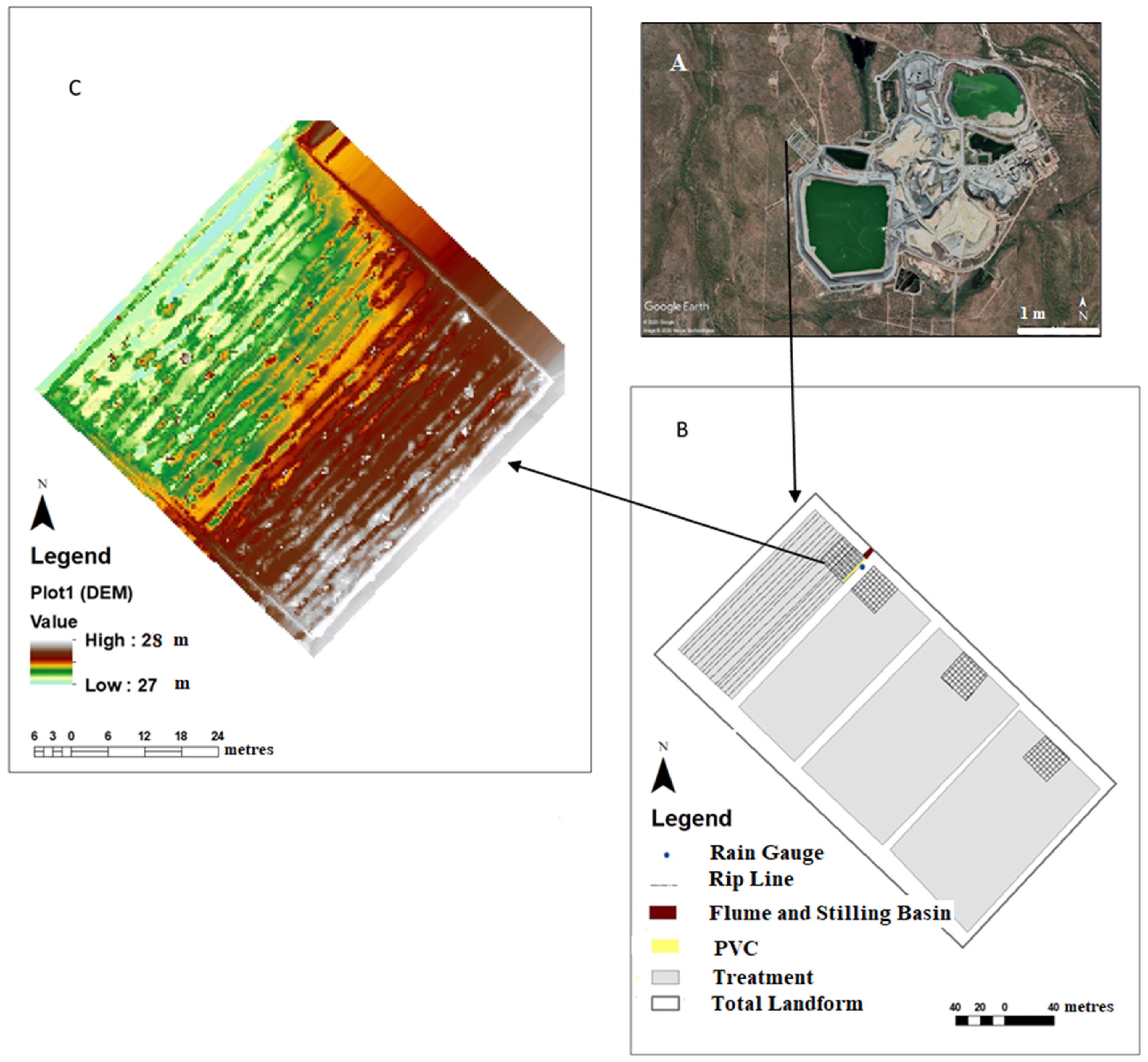



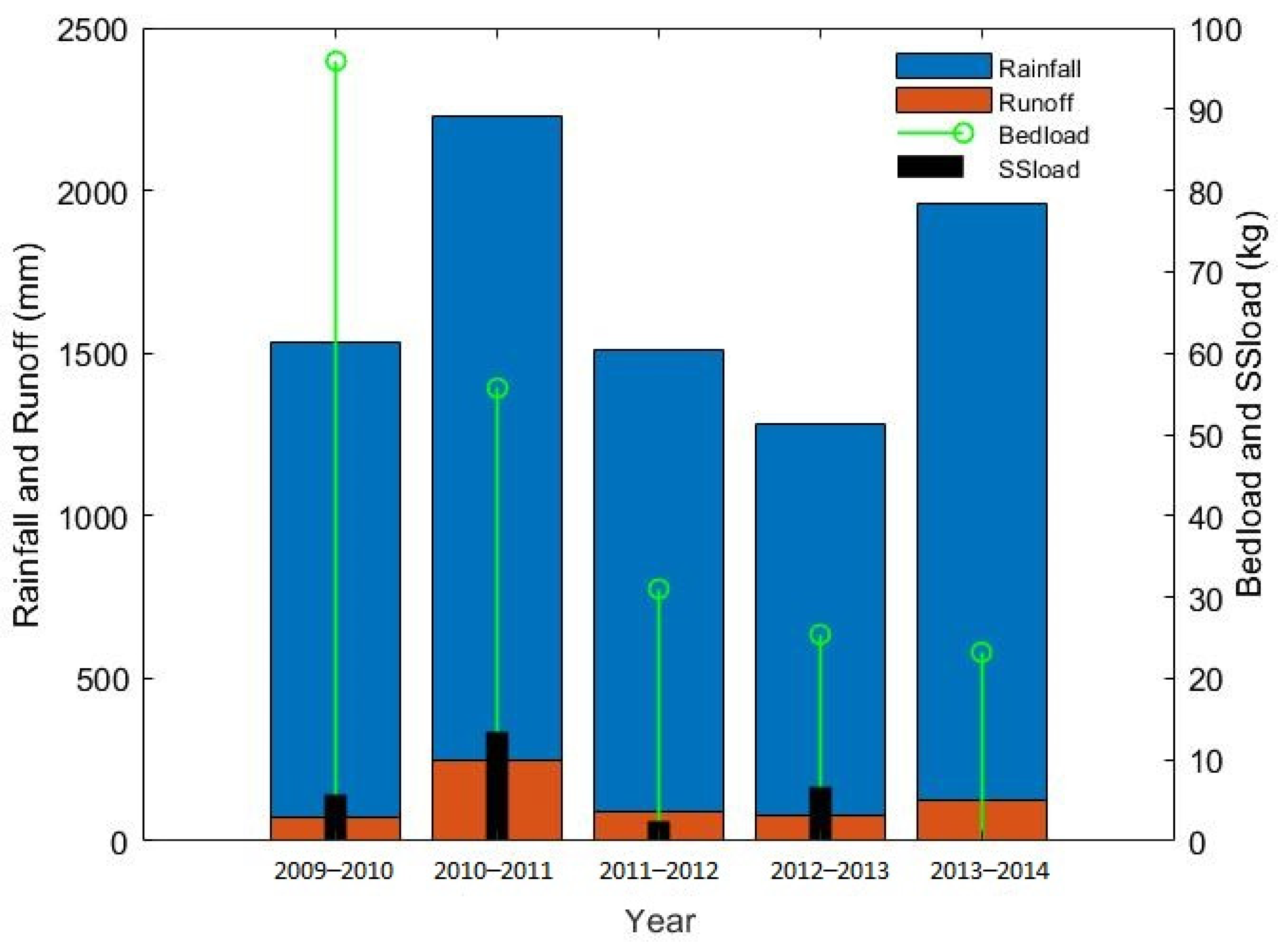
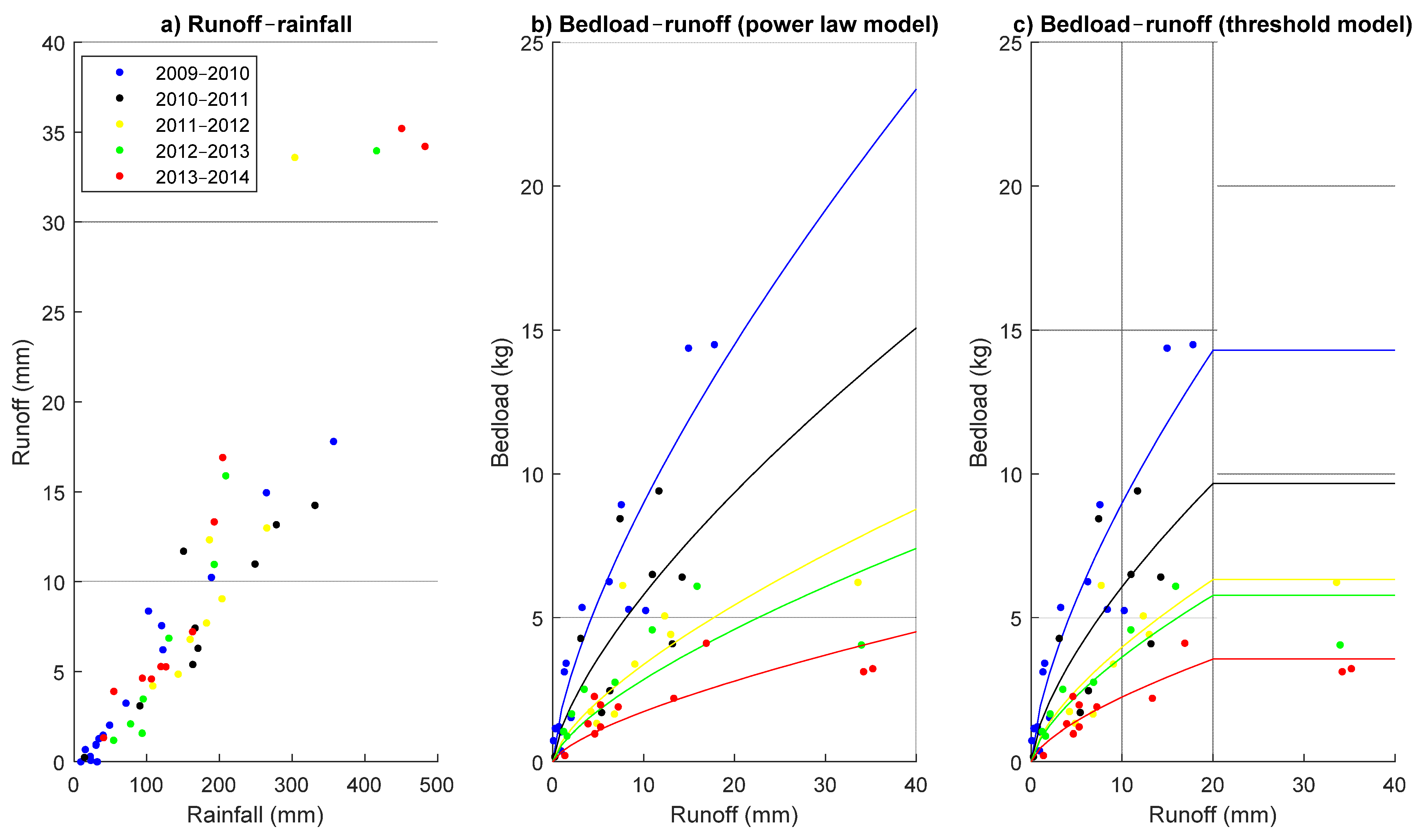
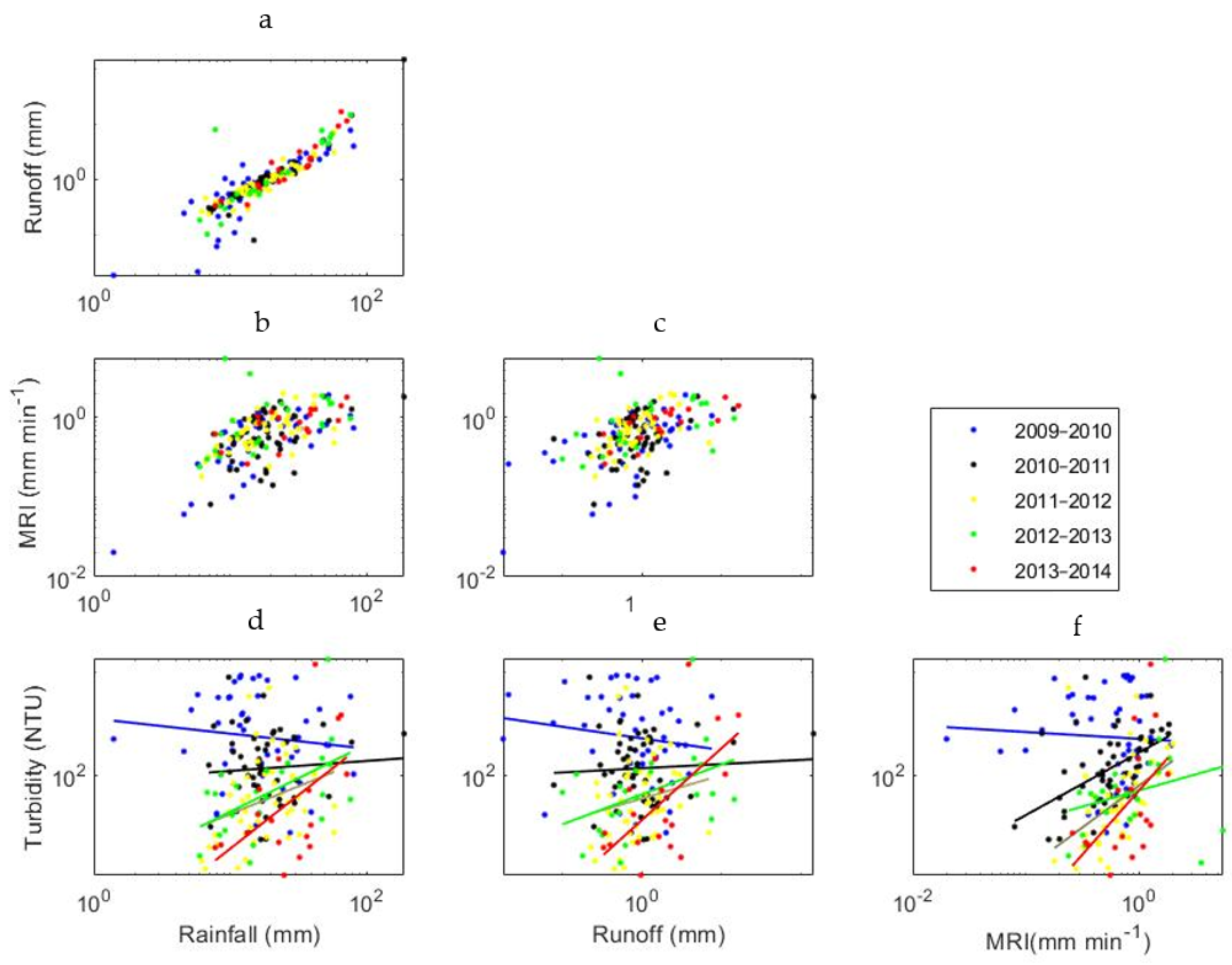
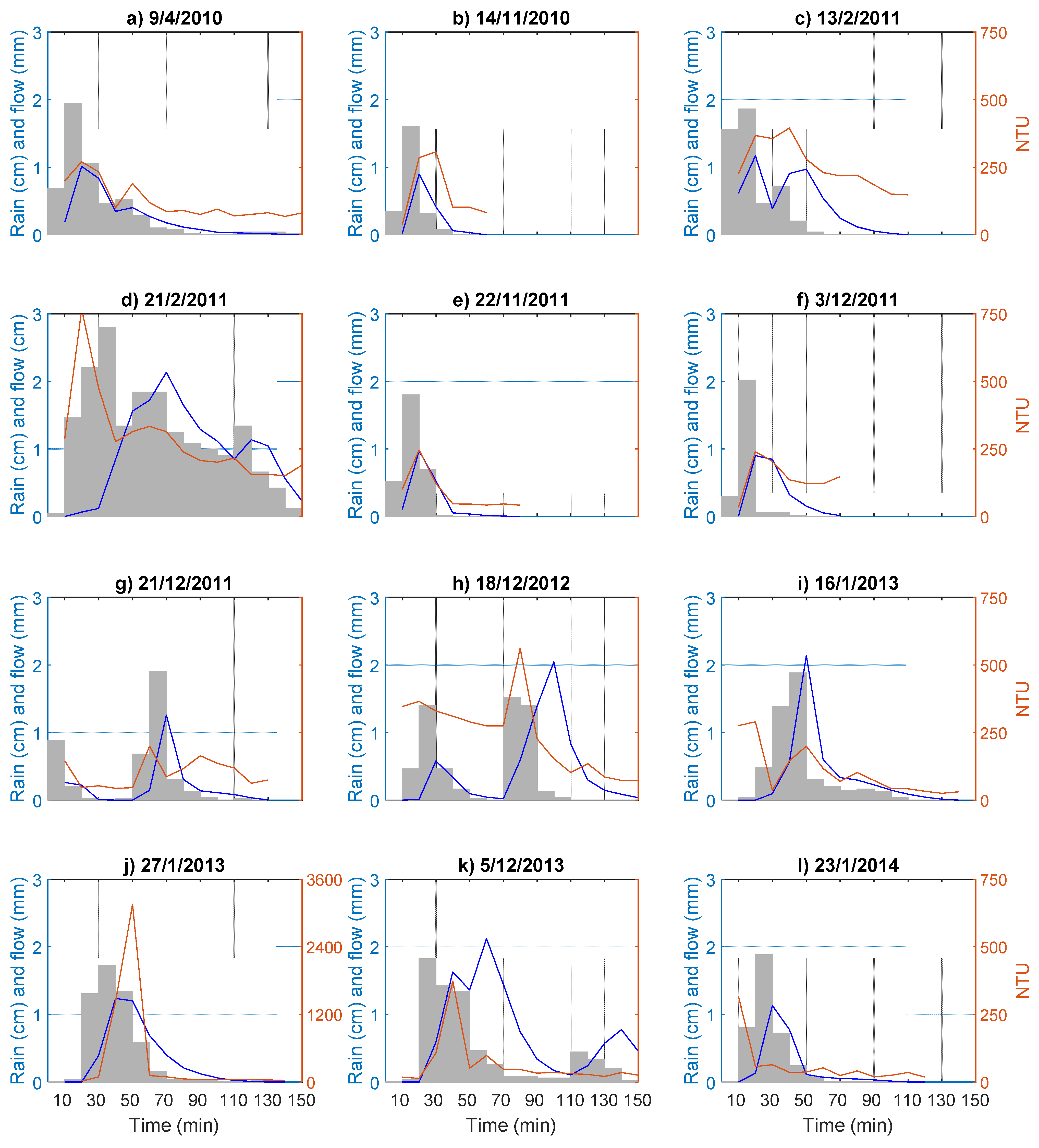
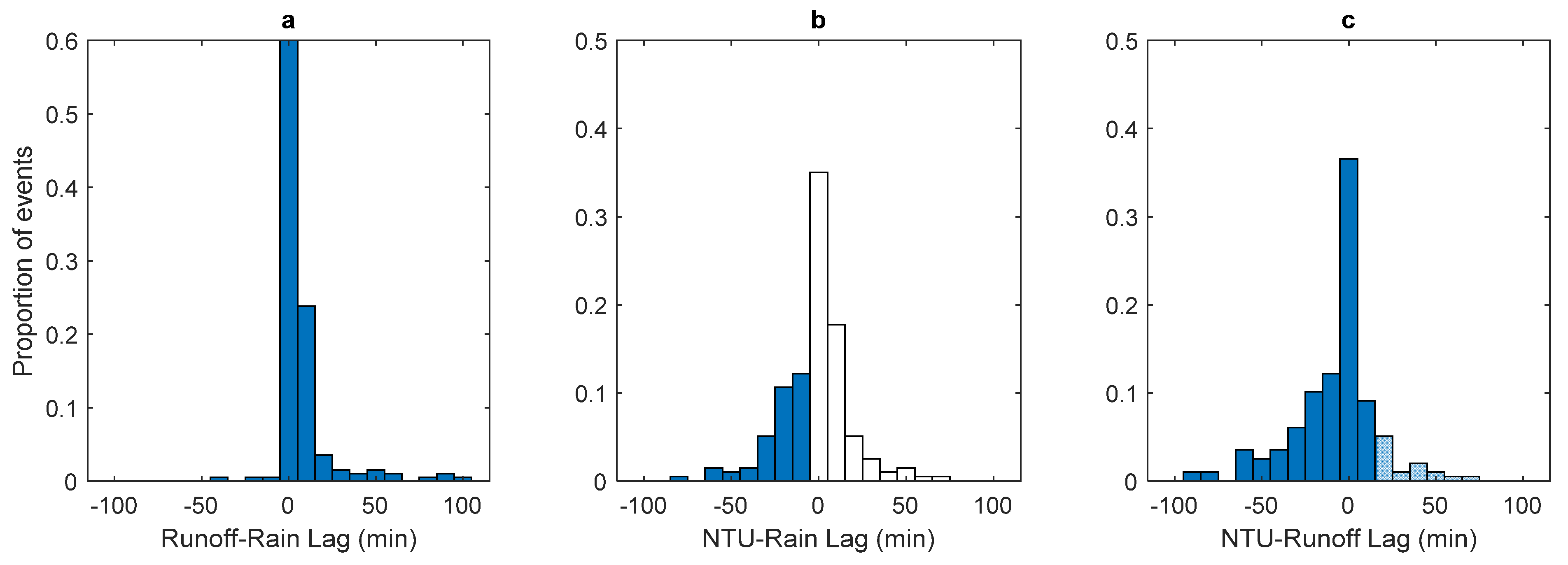
| Statistic | 2009–2010 | 2010–2011 | 2011–2012 | 2012–2013 | 2013–2014 |
|---|---|---|---|---|---|
| Number of events with sufficient nephelometric turbidity units (NTU) data | 44 | 53 | 44 | 24 | 18 |
| Runoff coefficient—mean (standard deviation) over events | 0.05 (0.02) | 0.06 (0.09) | 0.05 (0.01) | 0.08 (0.1) | 0.06 (0.04) |
| Event duration—mean (standard deviation) over events (min) | 162 (206) | 126 (104) | 110 (99) | 111 (119) | 165 (113) |
| Rainfall volume mean (standard deviation) (mm) | 21.3 (17.7) | 22.7 (26.2) | 20.6 (12.2) | 26.1 (20.2) | 32.2 (19.1) |
| Runoff volume mean (standard deviation) (mm) | 1.2 (1.7) | 3.9 (18.5) | 1.1 (1.1) | 2.7 (3.1) | 3.3 (3.6) |
| Maximum rainfall intensity (MRI) mean (standard deviation) over events (mm 10 min−1) | 0.64 (0.38) | 0.69 (0.42) | 0.78 (0.42) | 1.17 (1.2) | 0.9 (0.4) |
| Runoff weighted turbidity—mean (standard deviation) over events (NTU) | 351 (282) | 159 (146) | 95 (133) | 127 (257) | 143 (279) |
| Runoff weighted turbidity—median over events (NTU) | 252 | 109 | 53 | 66 | 34 |
| R2 (p-value) by regressing log10(NTU) against log10(rainfall) | 0.02 (0.6) | 0.006 (0.9) | 0.20 (0.04) | 0.28 (0.04) | 0.41 (0.02) |
| R2 (p-value) by regressing log10(NTU) against log10(runoff) | 0.02 (0.3) | 0.003 (0.7) | 0.03 (0.04) | 0.19 (0.04) | 0.39 (0.006) |
| R2 (p-value) by regressing log10(NTU) against log10(MRI) | 0.004 (0.7) | 0.27 (0.0001) | 0.22 (0.001) | 0.07 (0.23) | 0.26 (0.03) |
| R2 (p-value) by regressing log10(NTU) against log10(rainfall), log10(runoff) and log10(MRI) | 0.02 (0.6) | 0.31 (0.0001) | 0.34 (0.005) | 0.28 (0.1) | 0.41 (0.02) |
Publisher’s Note: MDPI stays neutral with regard to jurisdictional claims in published maps and institutional affiliations. |
© 2021 by the authors. Licensee MDPI, Basel, Switzerland. This article is an open access article distributed under the terms and conditions of the Creative Commons Attribution (CC BY) license (https://creativecommons.org/licenses/by/4.0/).
Share and Cite
Yavari, S.; McIntyre, N.; Baumgartl, T. An Empirical Analysis of Sediment Export Dynamics from a Constructed Landform in the Wet Tropics. Water 2021, 13, 1087. https://doi.org/10.3390/w13081087
Yavari S, McIntyre N, Baumgartl T. An Empirical Analysis of Sediment Export Dynamics from a Constructed Landform in the Wet Tropics. Water. 2021; 13(8):1087. https://doi.org/10.3390/w13081087
Chicago/Turabian StyleYavari, Shahla, Neil McIntyre, and Thomas Baumgartl. 2021. "An Empirical Analysis of Sediment Export Dynamics from a Constructed Landform in the Wet Tropics" Water 13, no. 8: 1087. https://doi.org/10.3390/w13081087
APA StyleYavari, S., McIntyre, N., & Baumgartl, T. (2021). An Empirical Analysis of Sediment Export Dynamics from a Constructed Landform in the Wet Tropics. Water, 13(8), 1087. https://doi.org/10.3390/w13081087







